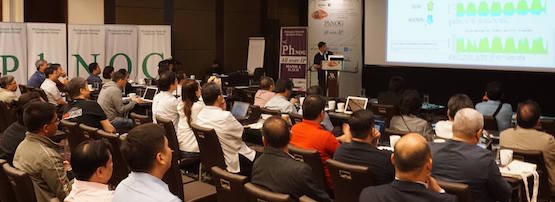
I was lucky enough to be invited to the PhNOG meeting just held in Manila, where I presented on the RPKI activity in APNIC.
Event Wrap: PhNOG 2016, Philippines
Around 70 participants from a very well connected and active community came together for the one-day meeting to discuss a range of topics relevant to the industry.
I thought I’d share with you some of talking points I took away from the event.
Cloud based in-house development
Rhett Jones from Synacy presented on the cloud-backed tools his company is using to drive their in-house development. Almost every level of their work is supported from externally sourced and operated software, leaving a small focused set of in-house developments to drive their innovation.
When I say almost every level, I really mean it: Rhett took us through a list from building access, payroll, internal group communications, HR (hiring and rewards and recognition) through help-desk, trouble ticketing, on-call staff scheduling and software development and testing, all of it runs on packages sourced outside the company.
I spoke to Rhett after his presentation, and he’s adamant this tool has reduced TCO of the company, and increased efficiency because of avoiding internal support and development costs. Synacy has over 60 people working in Cebu, Philippines, with future growth potential as they develop their business model.
APNIC uses a number of external applications like everyone else does these days, but we still maintain significant in-house development and support staff. It made me wonder if you kick-started registry services now, how many of them you would develop and how many you would source externally? I am not dis-respecting our great internal software development and operations staff, but noting there are choices to be made now, which perhaps didn’t exist 15-20 years ago.
A noticeable change in people’s viewing habits: handheld devices vs. TV/laptop/desktop
Softbank/BB presented on their view of emerging Internet opportunities in Asia. Mostly this was of interest to the ISP sector discussing where they peer and why, reflecting the traffic flows to and from their core market (Japan). However, they had some very interesting information on the kinds of ‘eyeball’ engagement now seen.
Notable to me, was that screen time on handheld devices (phones, tablets, phablets) now exceeds television and laptop and desktop time considerably, per user on a daily basis. I guess we all knew that if you look at what people do in coffee shops, at lunch, and on public transport but I hadn’t quite taken in that the aggregate time spent looking at my phone is probably two to three times more than the amount of time I engage with television, even if I watch one hour of news every night. Scary!
Some news from Akamai’s State of the Internet report
Akamai presented their 2015 ‘State of the Internet’ report.
It was fascinating to see the CDN view of end user bandwidth, which is a function of their role, providing a huge variety of content worldwide, located in ISPs and at IXs, so they have good data on the shortest-path, lowest-RTT achievable into many economies.
The Philippines has a long way to go on these rankings, but this isn’t news to anyone, especially in the PhNOG meeting who are after all the people mediating access from content to customer. What might be news, or rather a question worth re-asking, is why do you need to keep peering with an agency like Akamai, even if they are embedded in your network?
It pays to have redundancy, and when it’s the majority of your content, it pays to ensure your local copy isn’t a single point of failure. Akamai and the other content providers will always preference the better path, but if you only have one, even internally, you’re exposed to risks.
Akamai also reminded us that IPv6 is something they understand well, but they cannot force the content, which requires them to use dual-stack. So, even though Akamai is completely ‘tooled up’ to deliver dual-stack service delivery, the prime content owners have to consent. It would pay for us to make sure the content which is on Akamai understands the primacy of IPv6 access – so the message gets through!
ISOC support PHOpenIX
Jane Coffin and Kevin Meynell presented on the ISOC activities, which relate directly to the ISP sector. These included ISOC’s support of the development of the Philippines Open Internet Exchange (PHOpenIX), and the MANRS/Deploy-360 programmes.
The PhNOG organizers were very gracious and acknowledge the engagement of ISOC, NSRC, and APNIC along with Cisco, PCH and others in helping encourage participation and dialogue among the Philippine operations community about the development of PHOpenIX. This was instrumental in opening the local community to hosting root servers and now supports six instances of the 13 DNS root labels as anycast nodes.
The views expressed by the authors of this blog are their own and do not necessarily reflect the views of APNIC. Please note a Code of Conduct applies to this blog.
